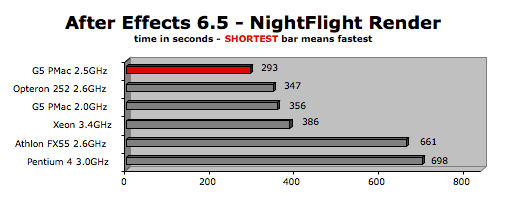
Posted on 02/19/2005 7:38:55 PM PST by Swordmaker
This is the "early 2005" version of what is consistently one of our most popular reports. I was recently invited by San Diego Supercomputer Center (SDSC) and WhisperPC to help test a Dual 3.4GHz Xeon system and a 64 bit "3500+" (2.2GHz) Athlon system. They were trying to choose a high end PC to use as their recommended workstation for themselves as well as for those remote scientists wanting to run the custom visualization software produced at SDSC and commercial applications (like Maya).
Though the G5 Power Mac wasn't being considered by SDSC, I thought it was a perfect time to refresh the "Mac versus PC" report on our site. I included the results from last year's 3GHz Pentium 4 test as a reference point. We'll test a faster Pentium 4 system as soon as it's available to us.

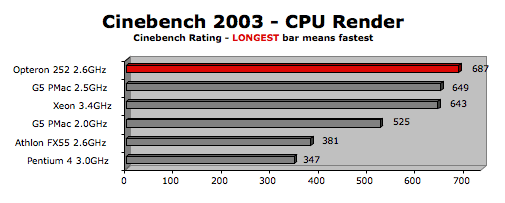
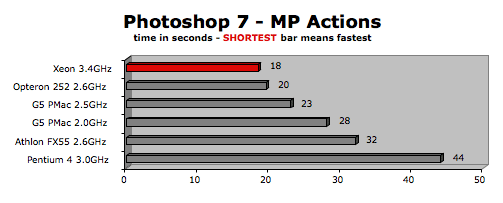
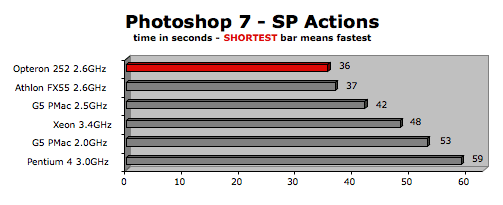
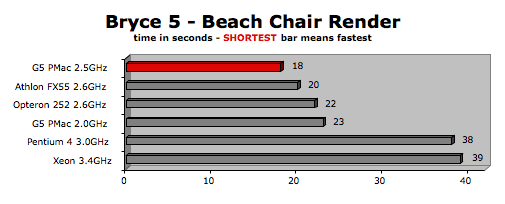
(watch this space for Maya results in a few days)
INSIGHTS and COMMENTS
1. I'm often accused of choosing applications that favor the Mac. That makes me chuckle when you consider that, when I first started the "Mac versus PC" shootouts, the G4 Power Mac only won one test: Photoshop "MP." Ironically, in this round of testing, the top G5 Power Mac (dual 2.5GHz) won every CPU intensive test except the Photoshop "MP."
2. The first three graphs above show the power of having dual processors. The last two show how non-MP "aware" apps or functions give single processor systems "equal footing" with the dual processor units. However, if you have two active non-MP aware apps running simultaneously, the Power Mac gets both processors involved. I assume the same is true of the Windows XP based systems.
3. The test units had different memory configurations ranging from 2GB to 4GB. However, since we were running one task at a time, even 1GB would have produced the same results as 4GB. But for the record, this was the configuration:
Dual G5/2.5GHz Power Mac = 4GB of 400MHz DDR
Dual G5/2.0GHz Power Mac = 4GB of 400MHz DDR
Dual Xeon 3.4GHz = 4GB of 400MHz DDR
Pentium 4 3GHz = 2GB of 400MHz DDR
64 bit Athlon 2.2GHz = 3GB of 333MHz DDR
4. The boot drives varied in speed and interface from system to system, but the tests we ran and the way we ran them did not involve any disk activity.
5. We didn't specify graphics cards on this page because the tests we ran netted the same results, no matter what card we used. In other words, we successfully isolated the CPU. There is a new trend to involve the graphics card in what has been traditionally CPU only rendering, as we have seen with Maya and Motion. We plan to add Maya results in a few days but Motion is Mac only.
Though the Dual G5 Power Macs did well against the Windows based machines in the CPU intensive tests featured on this page, the 3D graphics tests were a whole other matter. Be sure to check out our "GRAPHICS" PAGE TWO before you trade in your PC for a Mac. ;-)
Since my interest was "upgrading" our Mac versus PC shootout, I tested the same graphics intensive apps on a G5/2.5 Power Mac with the two best graphics cards available: the GeForce 6800 Ultra DDL and Radeon X800 XT (8X AGP Dual-Link graphics cards).

SPECviewperf is a standardized graphics benchmark that's available in a Windows and Unix version. Since Mac OS X is Unix "on steroids," I compiled the Unix version using Mac developer tools (Xcode 1.5) with the help of instructions posted by Marcel Bresink. SPECviewperf simulates eight different real world apps. We chose the Maya animation simulation to graph.
The emphasis in SPECviewperf is polygons and lots of them. On the other hand, when you play a 3D Game, there is an emphasis on pixels and shading.
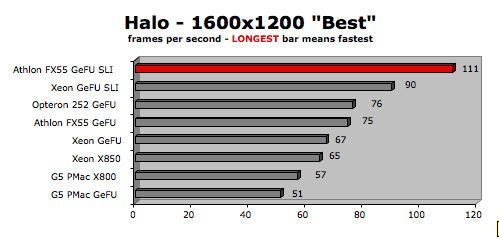
Halo is a great cross platform test since it uses advanced shading technologies. Notice we included results for dual nVidia graphics cards joined together in "SLI" mode.
LEGEND of GRAPHS
Xeon = Dual 3.4GHz Xeon (PCI-Express)
Athon = 64 Bit Athlon 3500+ (2.2GHz, PCI-Express)
G5 = Dual G5/2.5GHz Power Mac (8X AGP)
GeFU = nVidia GeForce 6800 Ultra (PC Edition - PCI-Express and Mac Edition - 8X AGP) GeFGT = nVidia GeForce 6800 GT (PC edition; PCI-Express)
QuFX = nVidia Quadro FX 3400 (PC Edition; PCI-Express)
FireGL = ATI FireGL V7100 (PC Edition; PCI-Express)
X850 = ATI X850 XT (PC Edition; PCI-Express)
X800 = ATI Radeon X800 XT (Mac Edition; 8X AGP)
SLI = nVidia's Scan Line Interleave (SLI) multi-gpu technology; two PCI-Express cards are linked together using jumper with SLI mode enabled in the driver.
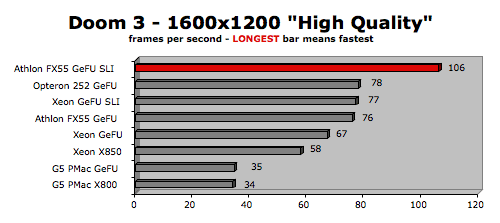
The popular Doom 3 game will soon be released on the Mac, so we're adding it to our cross-platform suite of tests. We reran this test using the default "Demo1" instead of our captured sequence. Since none of the cards had more than 256MB of video memory, we ran the High Quality setting instead of Ultra.
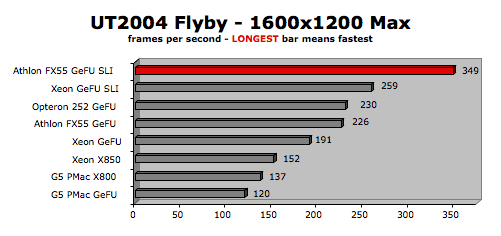
We ran the "Inferno" map in the Unreal Tournament 2004 test, using the SantaDuck Toolpak for both Mac and PC. SLI mode speeds up the Flyby but does very little for the Botmatch as you can see below.
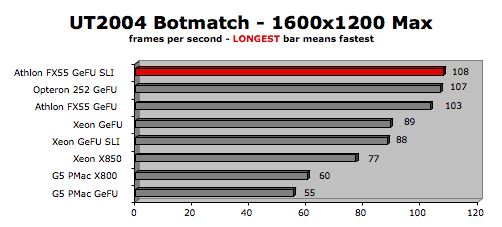
The Botmatch simulates game play more closely than the Flyby. Therefore the framerates are more in line with what you'll see when you are actually playing the game.
INSIGHTS and COMMENTS
1. Though the G5 Power Macs did well in the CPU tests, they were pretty much "smoked" in the 3D GRAPHICS tests. Part of it as to do with how much effort developers put into optimizing (or re-writing) the game code to take advantage of the unique features of the G5 Power Macs. Quake 3 Arena, though considered obsolete by avid gamers, is a perfect example of the potential of the G5 Power Macs to excel in gaming:
One of the lead programmers at Id Software (Graeme Devine) took a personal interest in optimizing the Mac version to take advantage of the Power Mac's Velocity Engine and Dual Processors.
2. The more expensive "workstation" (professional grade) graphics cards like the Quadro FX and FireGL beat all the "desktop" (consumer) graphics cards when running the polygon intensive SPECviewperf test. But the "desktop" GeForce 6800 Ultra was the "king" of 3D gaming.
3. Dual-Link DVI, as you know, is required for "9 megapixel" displays (up to 3840x2400 resolution) like the Apple 30" Cinema. The high-end Dual-Link Mac compatible graphics cards may seem expensive to Mac users at $499 for the Radeon X800 XT and $599 for the GeForce 6800 Ultra. But the PC Dual-Link cards we tested ranged in price from $850 to $1200. I was able to "Google" up a handful of GeForce 6800s with true Dual-Link DVI support. The lowest price was $670. All at once, the Mac boards seem like bargains.
4. We had two each of the Quadro FX 3400 and GeForce 6800 Ultra cards, so we were able to try out nVidia's SLI multi-gpu technology where you bridge two cards in adjoining PCI-Express slots. Once you enable the mode in the driver, your graphics processing sub-system now has dual processors. So do you get double the performance? No, but if the software is SLI "aware," you will get significant gains as you can see by the Doom 3 and Halo graphs above.
Those are respectable gains when you consider the bandwidth is shared and the memory of each card mirrors the other. In other words, there is no gain in bandwidth or memory capacity by linking the cards.
5. PCI-Express has a theoretical bus speed twice that of 8X AGP, but I postulate that the bandwidth advantage is under utilized. The current generation of graphics cards and motherboard designs don't even saturate a 4X AGP bus. We're hoping to set up a sub-test with two Windows PCs of identical specs and identical graphics cards except one will have PCI-Express and the other 8X AGP. That comparison should prove or refute our hypothesis.
Mac SPEED TEST PING - latest PC vs Mac G5 shoot off...
If you want to be included or excluded on the Mac Ping list, FreepMail me.
Some interesting mixed results... CPU level stuff now that many things have been compiled and customized to work on the G5, the processor intensive tests show the G5 as generall faster...
BUT, on games and graphics to screen intensive work, despite having a very fast graphics card, the compilation and customization work has NOT been done and the G5 suffers badly in comparison.
Yep, it looks like the Wintel machines are good for games! If you want to do the serious lifting, get a Mac!
I noticed they didn't use dual Opteron 244s. Why? Because it would kick the crap out of the G4.
Perhaps... but according to the website:
February 18th, 2005, by rob-ART morgan, mad scientist with the help of the San Diego Supercomputer Center and Whisper PC. February 18th, 2005, 2PM Pacific TIme -- Dual Opteron 2GHz results were removed at the request of iXcomputer, the company that loaned us the system a year ago. Instead, they are letting us test a more current model with Single and Double 2.6GHz processor PCI-Express bus.
Is there a one paragraph translation of this in English?

See post #8.
Seriously, probably this one:
1. Though the G5 Power Macs did well in the CPU tests, they were pretty much "smoked" in the 3D GRAPHICS tests. Part of it as to do with how much effort developers put into optimizing (or re-writing) the game code to take advantage of the unique features of the G5 Power Macs. Quake 3 Arena, though considered obsolete by avid gamers, is a perfect example of the potential of the G5 Power Macs to excel in gaming:
*************

|
Good question
Price is $1,145.00.....
They were trying to choose a high end PC to use as their recommended workstation for themselves as well as for those remote scientists wanting to run the custom visualization software produced at SDSC and commercial applications (like Maya).
*************************************************
Cost was likely a factor in their choices, but can't be sure.
***********************************************
| $280.00 |  Add to Wish List |
||||||||
 |
|
$289.00 | |||||||
Yeah yeah. But how fast can it open MacPaint?
Why?
Ha ha ha!
LOL!
I had forgotten about 'MacPaint' !
Yeah, but, yeah, but, Dell sells a multiprocessor supercomputer desktop CPU which costs $19.95 (with shipping) and includes software that can model enough subatomic particle interactions to fill the entire Sun. And it comes with a free mousepad. [sense of irony alert]
Thanks for the ping.
eCost sells a Power Mac G5 2.5GHZ Dual Processor (only 512 Mb RAM) for $2,994.00
Monarch Computer sells an Athlon 64 3500+ (the 2.2 GHz CPU) for $1,085.00
Uh, not quite... that quote is for the SINGLE processor version, no Operating System, no software, no keyboard, no mouse, onboard sound, minimalist video, no modem, no NIC, No Firewire, no speakers.
After building one up as far as their build would allow (still only ONE [1] processor) and NO SOFTWARE equivalents... the price is $1944.97.
If you upgrade the MB and add the second Processor, guess what? The price is going to be close to $3000 and STILL NO SOFTWARE!
Disclaimer: Opinions posted on Free Republic are those of the individual posters and do not necessarily represent the opinion of Free Republic or its management. All materials posted herein are protected by copyright law and the exemption for fair use of copyrighted works.